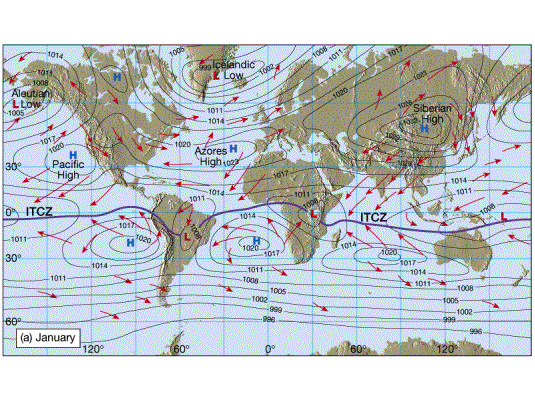a.) Tornadoes are primarily the result of an extreme supercell thunderstorm. During the storm, cold and warm air combine in a specific pattern to form the tornado (the cold air falls as the warm air rises).
An invisible horizontal spinning effect in the lower atmosphere is formed, until rising air within the thunderstorm's updraft rotates the air from horizontal to vertical. A lower cloud base in the center of the storm becomes a rotating wall clouds. Finally, a tornado develops and starts to wreak havoc.
After formation, the mesocyclone (rotating air) starts moving towards the ground. A small funnel appears to build up at the bottom of a wall cloud. As it reaches the ground, dirt is picked up and can result in the serious damage we have come to associate with tornadoes.
http://www.universetoday.com/75695/how-do-tornadoes-form/
b.) Tornadoes can appear from any direction, but most move from southwest to northeast.
c.) Tornadoes follow large thunderstorms which typically travel in a north-northeast direction because of the upper-level jet stream. An upper level jet stream is a movement of air that travels from west to east. Since hurricanes generally move from the south, they have their own upper-level jet stream and follow the air mass from west to east.
d.) Russia does experience tornadoes, but they are not as common as other places in the world. However, in 1904, Russia experienced the deadliest tornado of the century, the 1904 Moscow tornado, that killed over 400 people.
e.) Though many go unreported, it is estimated that the United States experiences over 1,000 tornadoes per year.
http://scienceline.ucsb.edu/getkey.php?key=1073
Reporting tornadoes is not common in Russia, therefore it is difficult to quantify the average number of tornadoes that occur during the year.
f.)
The southwest region of Russia experiences a fair amount of tornadoes throughout the year, while the rest of the large nation does not have any activity.
g.) Studies show that the increase of tornadoes of the past few decades may be completely unrelated to climate change factors.
-Population growth has led to more tornadoes being reported
-Advancements in weather radar have resulted in a much higher tornado detection rate
- Tornado damage surveys have grown more sophisticated in recent years. What me might have lumped together as one tornado in the past, we are no able to recognize as multiple tornadoes along a single damage path.
2. Hurricanes
a.) The formation of a hurricane requires at least three conditions. To kickstart formation, the ocean waters must be warm enough to where expend enough heat and moisture into the overlying atmosphere to provide the potential fuel for the engine that a hurricane becomes. Next, atmospheric moisture from sea water evaporation must combine with that heat and energy to form the powerful engine needed to propel a hurricane. Third, a wind pattern must be near the ocean surface to spiral the air inward. http://kids.earth.nasa.gov/archive/hurricane/creation.html
Russia is too far inland from any tropical (warm) waters, so any systems that would move in their direction would weaken before making it that far.
b.) Hurricane formation regions:
-Tropical storms that form above the equator and east/west of the Americas are called Hurricanes.
-Tropical storms that form below the equator and in the eastern hemisphere are called Cyclones.
-Tropical storms that form above the equator and in the eastern hemisphere are called Typhoons.
c.)
d.) As the hurricane moves north, it generally travels from west to east.
e.) When as storm starts to move northward, it abandons the trade winds and moves into the westerlies, the west to east global wind found at mid-latitudes. Since the westerlies move in the opposite direction from trade winds, the hurricane can reverse direction and move east as it travels north.
f.) Hurricanes do not occur in Russia.
g.) A typical season in the US, based on the years 1981-2010, sees six hurricanes. However, 2014 was predicted to be below average in hurricane events, and three to six are expected.
The waters surrounding Russia are too cold for the development of a hurricane. I was unable to find a website that told me the average number of hurricanes for the nation was zero.




